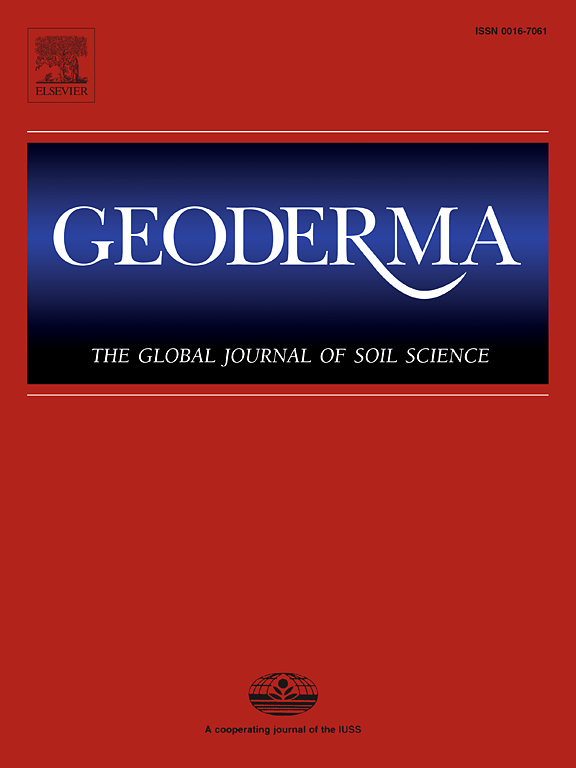Determining carbon storage of a complex peat stratigraphy using non– and minimal-invasive geophysical prospection techniques (Verlorener Bach and Loosbach valleys, southern Germany)
IF 5.6
1区 农林科学
Q1 SOIL SCIENCE
引用次数: 0
Abstract
This study investigates the stratigraphy and carbon storage of the Verlorener Bach and Loosbach valley fills, of the Alpine Foothills in Bavaria, using a combination of electromagnetic induction (EMI), electrical resistivity tomography (ERT), direct push electrical conductivity sensing (DP-EC) and drilling cores. We identified three distinct stratigraphic units, with Unit I consisting of gravel deposits, Unit II comprising Holocene peat layers, and Unit III containing redeposited carbonates and overbank deposits.
The integration of EMI data enhanced spatial resolution, while ERT data provided detailed insights into the thickness and distribution of these units. Correlating EMI-based apparent electrical conductivity values with stratigraphical data enabled the creation of a validated 3D model of sediment thickness. This approach revealed an inverted relief process where non-organic Unit III sediments remain elevated as surrounding organic-rich sediments shrink upon oxidation.
Additionally, geochemical analyses estimated the Total Carbon (TC) and Total Organic Carbon (TOC) content for Unit II, totaling 43 kt of TC and 35 kt of TOC across the entire 15-hectare study area. The high carbon storage in peatlands is attributed to the thickness of peat layers and sustained water saturation, preventing degradation. However, potential reductions in groundwater levels could lead to peat decomposition and carbon release.
This study demonstrates the effectiveness of integrating EMI, DP-EC and ERT data for stratigraphic analysis, providing a comprehensive understanding of spatial sediment stratigraphies and carbon storage in the study area. Our study demonstrates that it is possible to use geophysical prospecting methods not only to characterise surface sediments but also those located deeper in the ground. This allows for the analysis of both intact fen peats in terms of their carbon storage, as well as those that are no longer intact but buried.
利用非侵入式和微侵入式地球物理勘探技术确定复杂泥炭地层的碳储量(德国南部 Verlorener Bach 谷和 Loosbach 谷)
这项研究采用电磁感应 (EMI)、电阻率断层扫描 (ERT)、直推电导率传感 (DP-EC) 和钻孔岩心相结合的方法,对巴伐利亚阿尔卑斯山麓 Verlorener Bach 和 Loosbach 谷地的地层和碳储量进行了研究。我们确定了三个不同的地层单元,第一单元由砾石沉积组成,第二单元包括全新世泥炭层,第三单元包含再沉积碳酸盐岩和过岸沉积。将基于 EMI 的表观电导率值与地层数据相关联,可以建立一个经过验证的沉积厚度三维模型。此外,地球化学分析估算了第二单元的总碳(TC)和总有机碳(TOC)含量,整个 15 公顷研究区域的总碳(TC)和总有机碳(TOC)含量分别为 43 千吨和 35 千吨。泥炭地的高碳储量归功于泥炭层的厚度和持续的水饱和度,从而防止了退化。这项研究证明了将 EMI、DP-EC 和 ERT 数据整合到地层分析中的有效性,从而全面了解了研究区域的空间沉积地层和碳储量。我们的研究表明,地球物理勘探方法不仅可以用于表层沉积物的特征描述,还可以用于深层沉积物的特征描述。这样既可以分析完整的沼泽泥炭的碳储量,也可以分析不再完整但被掩埋的泥炭。
本文章由计算机程序翻译,如有差异,请以英文原文为准。
求助全文
约1分钟内获得全文
求助全文
来源期刊

Geoderma
农林科学-土壤科学
CiteScore
11.80
自引率
6.60%
发文量
597
审稿时长
58 days
期刊介绍:
Geoderma - the global journal of soil science - welcomes authors, readers and soil research from all parts of the world, encourages worldwide soil studies, and embraces all aspects of soil science and its associated pedagogy. The journal particularly welcomes interdisciplinary work focusing on dynamic soil processes and functions across space and time.
 求助内容:
求助内容: 应助结果提醒方式:
应助结果提醒方式:


